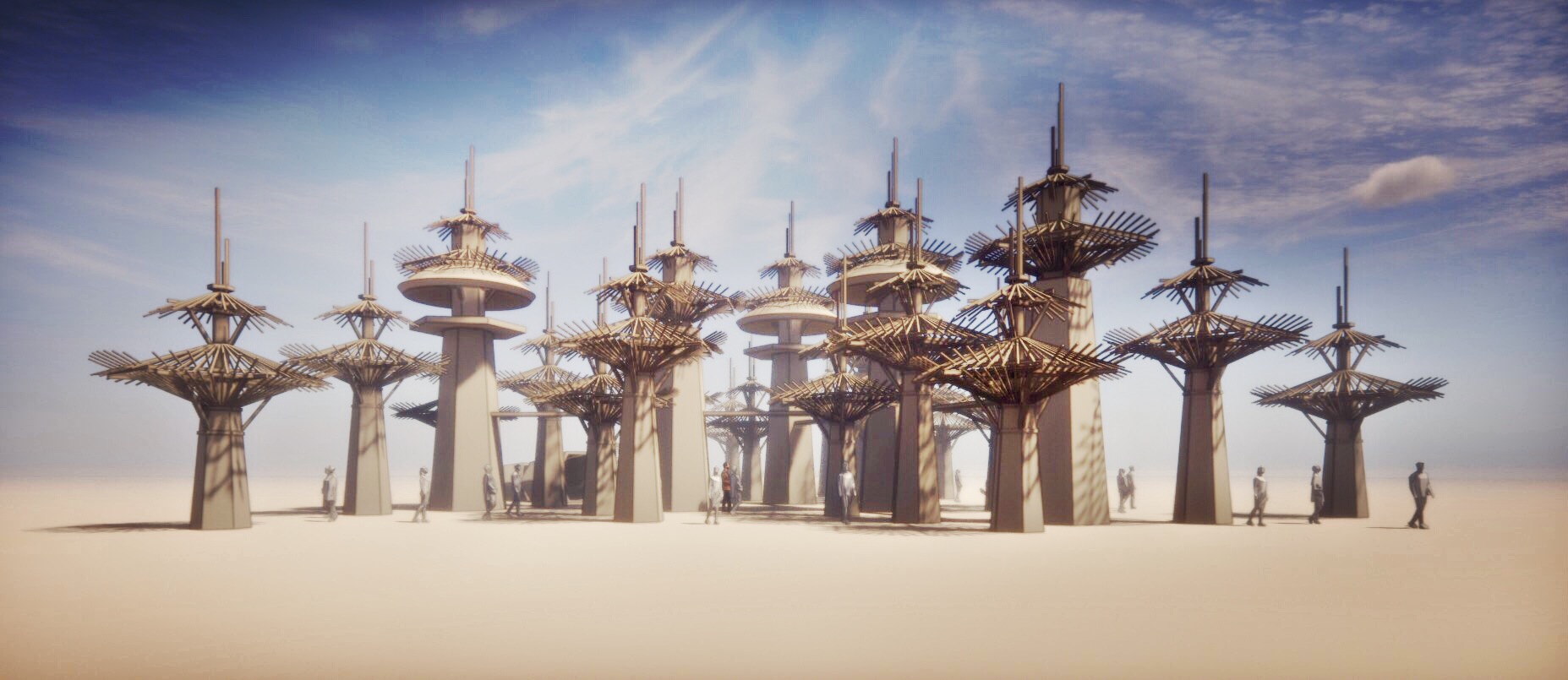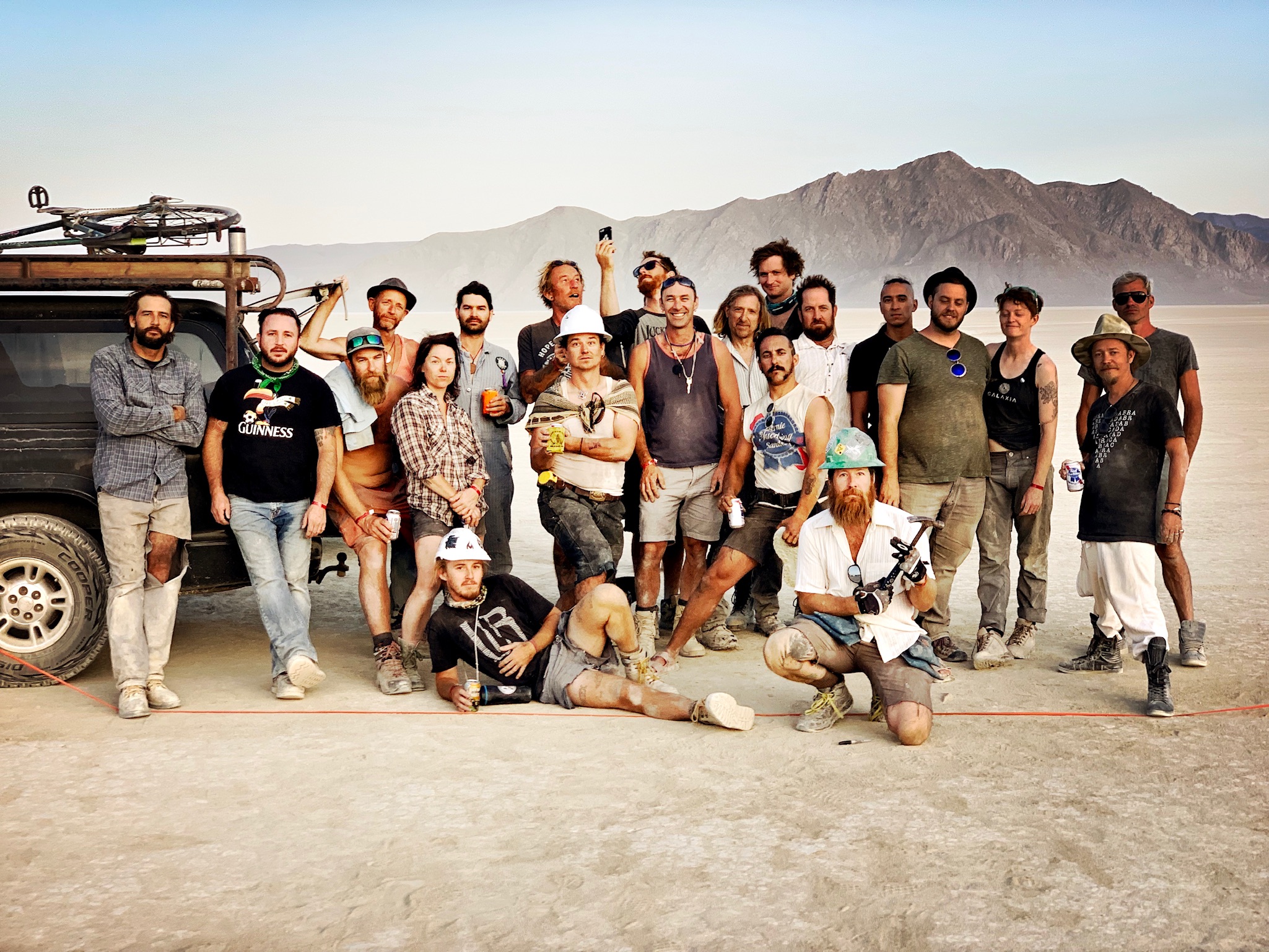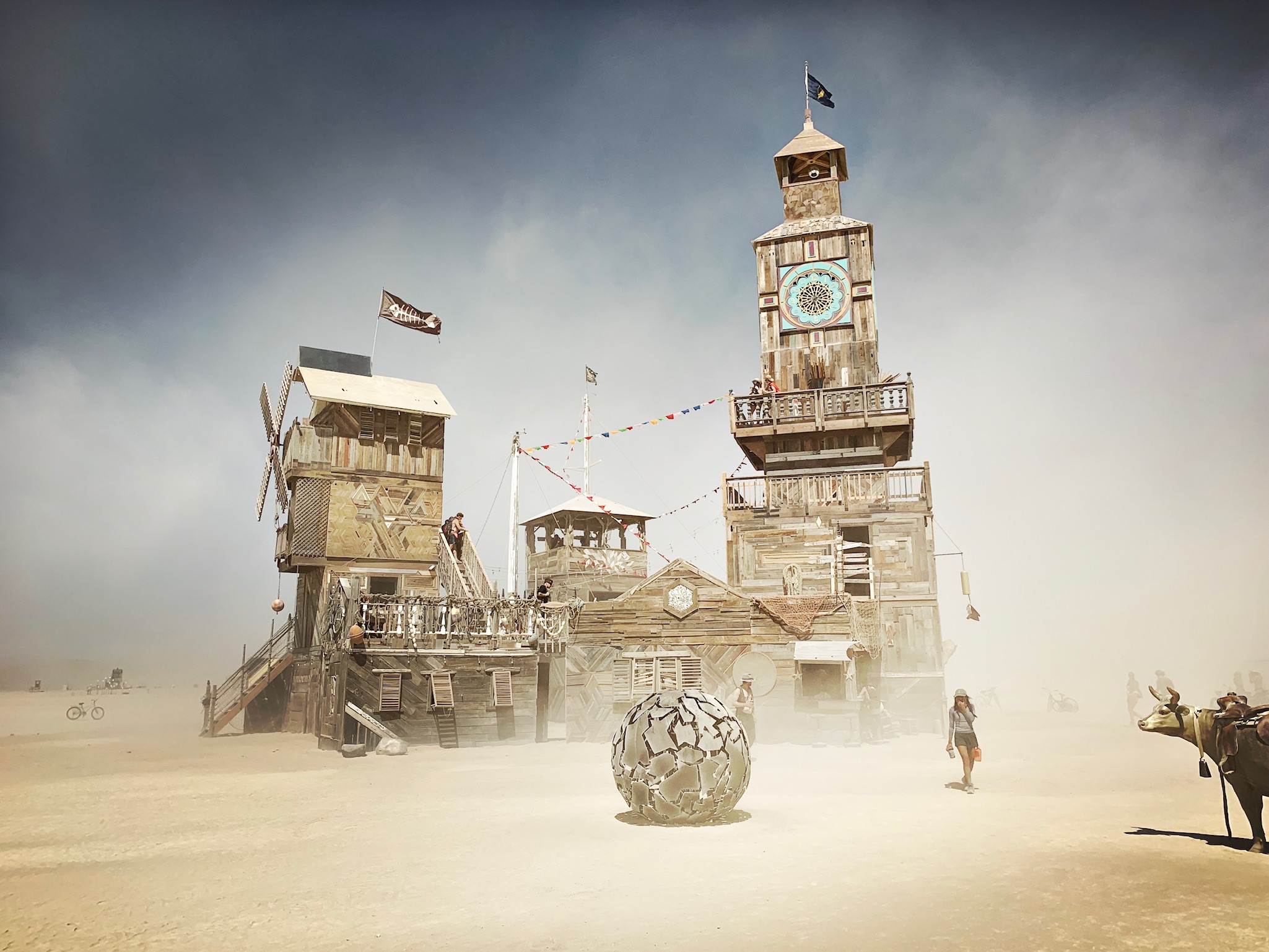For some organizations, sustainability is something they have to do, an add-on that helps keep integrity intact and values respected. For Folly Builders, sustainability is simply who they are. The Bay Area big art creators seamlessly weave environmental stewardship into their massive installations from inception through finale, manufacturing dazzling immersive experiences that refuse to place art before the planet.
In 2019, guided by their lead artist, Dave Keane, the crew brought their immense talent—individually and collectively, key members have played roles in many of the playa’s most notable Temples, Man Bases, and art pieces—to the creation of The
Folly, the mind-exploding fishing/mining village that enraptured visitors with its towering height, winding passageways, and near endless nooks and crannies.
Constructed primarily with reclaimed materials (though safety precautions required the use of virgin lumber for structural elements), including wood, ropes, clocks, and decorative elements, The Folly demonstrated just how far you could go when you give resources a second life.
It would be natural to take a massive breath after a project like The Folly—go off-grid, move to Italy, swear off chop saws and impact drivers forever. But the force of creation pulses strong through Dave and his band of badass makers. Before the
last embers of the burn had turned cold, the seed of the next big thing began to germinate. After a two-year COVID-enforced incubation period, Dave and his team will present Paradisium.

A comprehensive forest ecosystem, complete with flora and fauna, the Paradisium story continues where The Folly left off, a family of trees born from the regenerative power of the ashes left behind by the burned village. The symbolism is rich: life rekindling after a long period of death and destruction. Trees are intelligent, strong, and adaptive, and in Paradisium, they also become a clear reflection of Folly Builders’ dedication to creating dynamic, earth-friendly art experiences that stay with the participant long after the playa dust has settled.
Folly Builders are racing to complete Paradisium by a July 30 deadline, with the imminent shuttering of their long-time workspace (American Steel Studios in Oakland) nipping at their heels. Recently, Kai Dalgleish, a Paradisium interior design coordinator, took a break from the busy build to share their thoughts on the many ways Paradisium aligns with the sustainable-first ethos of the collective and to give us a behind-the-scenes peek into some of the innovative ways this human-made forest is up-leveling environmentally friendly big art.
The following are excerpts from our conversation, which took place in June 2022.

How did you get involved in Paradisium?
I got started doing art very early, and the thing that brought me into Burning Man art was experiential art, where you’re creating an experience for someone. I built a couple of Temples, which is about creating a place where people could add meaning to their lives and experience something more than just shiny visual art. That’s where I met Dave [Keane, lead artist] and where I met a lot of the people that I build with today. I have since moved on from Temples, doing big art projects. I am a visual artist and have a refined aesthetic sense, but for me, the building is about the joy of working really, really, really hard with people I care about and who care about me and producing something that’s bigger than anything any of us could have dreamed up by ourselves.
Now, let’s talk about sustainability. When does it become a factor in your projects—or is it present the whole time?
It’s kind of funny to think about sustainability because I don’t really know how to make art that isn’t made out of trash. We saw that a lot in The Folly, where we scavenged really hard. And it wasn’t just the wood that went into the piece, it was also raiding the dumpsters of our friends’ art projects. We had shop neighbors who would throw out their old prototypes, and we would go into their trash bins, with permission, of course, and pull out a cool laser-cut thing. We’d put it up on the wall, and it would become part of the decor. We didn’t have to buy plywood and use electricity to cut it or buy sandpaper and sand it down all nice. It was a piece that wasn’t going to get used that we reimagined into a new piece.

We’re doing that a lot with Paradisium. We’re soliciting other artists to make cameos and to become part of the ecosystem of the forest. We’re asking, “What are all the things that go into the forest?” We’ve got the trees, and are there birds in the forest? Are there mushrooms decomposing? And then looking to see if anyone is interested in contributing and encouraging them to use sustainable materials, partially out of necessity because if you’re buying a lot of materials, it ends up being expensive, and I don’t think any of us like when projects end up needing to raise hundreds and hundreds of thousands of dollars to create a limited-time experience.
A good example is the birds. I have a flock of geese, and I’ve been blowing out their eggs and saving them. What do eggs do? They sit in nests. So I put the call out, and someone said, my friend really wants to make nests. I suggested that we use ivy, which is an invasive species in the Bay Area, and someone suggested that we use ivy and kelp. And now we have this story about a bird flying all the way from the Black Rock Desert to the ocean to gather kelp for their nests, and we can have diagrams in the trees outlining the nutrient cycle there, where the iodine that comes from the ocean ends up back in the desert.
We’re tying in the necessity of making things out of found materials into the narrative of the piece. That way, sustainability becomes the piece. We’re not just looking for ways to swap things out. It is part of our art process to figure out how to do things in a way that doesn’t rely on buying new materials. There’s so much art that I love, but then think about what it takes to make that art. I’ve worked with fiberglass and resin. The results are beautiful; you can come up with really neat things, but when you’re mixing resin, you can feel how bad it is for the people working with it, and the end result is weird plastic that’s going to end up as trash or broken down into something. I think it’s really freeing to know that you’re not contributing to such a big problem through making your art, that you’re using natural materials, and you can put it in your compost pile when you’re done; it’s just goose eggs and kelp.
What are some of the less obvious ways you’re integrating sustainability into the Paradisium build?
Everything we can we source through salvage, from the cladding to the weird little art projects [featured throughout the forest]. We’re reusing HDUs or hold-down units, which are the big metal brackets that we use to anchor the piece onto the playa. That’s something we have to buy, and they’re really expensive. We knew that we were going to build more art after The Folly, so we pulled them out before it burned so we could reuse them. We also have a lot of decor and tools that we carry on from piece to piece. Any build project this big requires a lot of chop saws and battery-powered tools, so we’ve built up a shipping container that we use as our tool truck that gets moved from project to project.

And how do you address the environmental costs of shipping art to Black Rock City?
We do require shipping and using trucks to transport the project from the Bay Area out to the playa. The way we address that is with experience and expertise. We have really great people who have worked on a lot of art projects, so when we’re designing anything, the trees for Paradisium included, we think about how we’re going to ship it in as few trucks as possible, both for cost and carbon footprint. Paradisium is made up of several different sizes of trees, and they are designed to either be flat packed where we disassemble them and stack them up, which means we can fit a lot on one truck, or they are designed to be nested on top of each other so we can stack them like little Russian dolls. As we’re doing the very initial drawings for a project, we’re always thinking through the end stages, asking, how can we make this as efficient as possible to build so it is low cost, so we’re not sending 30 trucks out to playa, and so it will be easy to build once we get out there? The sustainability aspect of it is all related to efficiency, and it benefits us, too; it’s not just something we’re slapping on at the end.
I understand that Paradisium will not be burned. What influenced that decision and how does it support Folly Builders’ sustainability objectives?
I used to do a lot of environmental activism, sitting in trees where I was putting my life on the line to stop logging. Ten years later, I found myself working on Temples at Burning Man. These were art projects that would buy $200,000 of virgin lumber and then light it on fire after it’s been up for a week.
The Folly was the first large-scale project that I worked on that wasn’t a Temple, and I definitely had some feelings as it burned—after we had put so much work into it. We will be disassembling Paradisium at the end of the event. This will enable us to find new places to bring it, and we won’t be lighting resources on fire every time we build an art project. We’ll be able to carry on that same impact with people without having to cut down more trees. Disassembling it is much more difficult than lighting it on fire and scraping up the ash. This is the first time for some of us that we’ve done this. It will be the first time for me. I’m excited to see how it turns out—and a little anxious.
Support Paradisium aka The Folly Forest!
- Support the Paradisium 2022 fundraiser and get fun schwag
- Learn about tax-deductible donations and employee donation matching
Follow Paradisium & Folly Builders
- Subscribe to the Folly Builders’ mailing list for build updates & volunteer opportunities
- Follow Folly Builders on Facebook
- Follow Paradisium on Instagram
Cover image of Paradisium by Dave Keane & Folly Builders, 2022 (Image courtesy of the artists)


Wow, I am so looking forward to seeing this on the Playa. Amazing work, thank you for sharing it with us.
Report comment
The folly was amazing! Unfortunately, it was also completely inaccessible for wheelchair users, those who cannot navigate stairs, etc.
Report comment
Very cool, can’t wait to see it on the playa!
Report comment
If the Tickets arrive in time for build teams that would be nice. Why wait until the last second to try to ship thousands of tickets?
Report comment
David. Always building something from nothing, living the legend, believing it into existence, bringing joy to those who seek it. Respect, fella.
Report comment
Comments are closed.